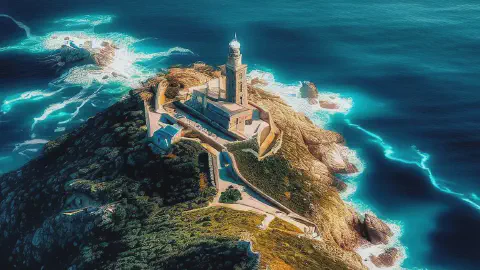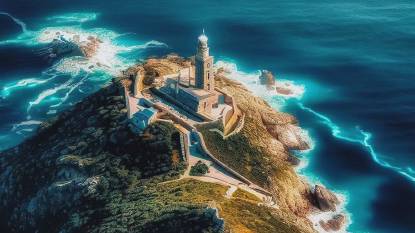
Camino Francés: Arzua to Finisterre - Stage 25
Posted: | Updated:
Reading time: 8 minutes
Camino Francés: Arzua to Finisterre - Stage 25
Posted: | Updated:
Reading time: 8 minutes
By: Simon Kemp, Editor
Navigating the entire length of the Camino Francés often requires logistical planning, especially when time constraints or physical limitations don’t allow for completing the entire walk. If you find yourself in Arzua with the goal of reaching the coastal town of Finisterre, the ‘end of the world’ for many pilgrims, rest assured there are efficient ways to do so.
Two convenient options include taking a bus or hiring a taxi. While each has its own advantages and potential drawbacks, both modes of transport offer a comfortable and scenic journey through the heart of Galicia. This guide will walk you through the details of organizing either mode of travel for a smooth trip from Arzua to Finisterre.
The previous leg of the Camino Francés is Palas De Rei to Ribadiso De Baixo or Arzua
Most pilgrims on the Camino Francés finish their journey in Santiago de Compostela, but some choose to continue west toward Finisterre, a coastal town once thought to be the edge of the known world. This detour takes walkers beyond the traditional endpoint, offering a different kind of experience—one that connects the pilgrimage to the sea. Some pilgrims extend their journey even further to Muxía, another coastal destination with its own spiritual significance.
Historical Background
- Arzúa: Located in Galicia, Arzúa is one of the last major towns before reaching Santiago. It has long been a stopping point for pilgrims, with historical references in the Codex Calixtinus, a 12th-century guide to the Camino. The town is known for its cheese-making tradition, and its Church of Santiago has welcomed travelers for centuries.
- Finisterre: The name comes from the Latin Finis Terrae, meaning “end of the earth.” Before the discovery of the Americas, this was believed to be the westernmost point of Europe. The town has deep maritime traditions, and its lighthouse, built in 1853, stands as a landmark for pilgrims who complete their journey at the sea.
- Muxía: Located further north along the coast, Muxía is known for its connection to Galician legends and the Sanctuary of Virxe da Barca, a church overlooking the Atlantic. According to tradition, the Virgin Mary arrived here by boat to encourage St. James in his mission. The town is also famous for its stone formations, including the Pedra de Abalar, a large rock believed to have mystical properties.
The Camino Route
The walk from Arzúa to Finisterre is approximately 90 km (56 miles) and takes about four days to complete. The route passes through forests, rolling hills, and coastal landscapes, offering a mix of terrain.
- Arzúa to Negreira (33 km): The first stretch follows quiet country roads and woodland paths, passing through Vilaserío before reaching Negreira, a town with a medieval bridge and a 17th-century pazo (manor house).
- Negreira to Olveiroa (34 km): The route continues through forested trails and open countryside, with small villages along the way. Olveiroa is a common resting point, offering accommodations and food.
- Olveiroa to Cee (19 km): This section brings pilgrims closer to the coast, with views of the Atlantic Ocean appearing near Cee, a fishing town with a lively harbor.
- Cee to Finisterre (15 km): The final stretch follows the coastline, passing through Corcubión before reaching Finisterre, where pilgrims often visit the lighthouse and leave symbolic offerings.
Arzua to Finisterre Route Map
Alternative Route to Muxía
Pilgrims who wish to visit Muxía can take an alternative path from Hospital, where the Camino splits. The route to Muxía is 31 km (19 miles) from Olveiroa, passing through Dumbría before reaching the coast. Some pilgrims walk from Finisterre to Muxía, a 28 km (17-mile) journey along the rugged coastline.
Coastal Paths and Scenery
The final stages of the Camino to Finisterre and Muxía offer some of the most striking coastal views in Galicia. The paths near Cee and Corcubión provide glimpses of sandy beaches and rocky cliffs, while the approach to Finisterre Lighthouse is marked by dramatic ocean panoramas. The route to Muxía follows sections of the Costa da Morte (Coast of Death), named for its treacherous waters and shipwreck history. Pilgrims walking this stretch often encounter windswept cliffs, fishing villages, and quiet coastal trails, making it a unique contrast to the inland Camino.
This route offers a different perspective on the pilgrimage, shifting from rural Galicia to the Atlantic coast. Many pilgrims see it as a symbolic way to end their journey, watching the sunset over the ocean as a final moment of reflection
How to Take a Bus from Arzua to Finisterre
The Camino de Santiago, also known as the Way of Saint James, is one of the most iconic pilgrimages globally. However, not everyone has the time or the physical ability to complete the entire walk. If you’re in Arzua and want to make your way to the coast of Finisterre, taking a bus can be an efficient and affordable option. Here’s how you can do it.
Booking Your Bus
In Arzua, bus services to Finisterre are not direct and will require at least one transfer, typically in Santiago de Compostela. The first step in your journey will be getting from Arzua to Santiago.
Monbus is the primary bus service operating in this area. You can check their schedules and book your ticket from Arzua to Santiago de Compostela on their website. Be sure to book in advance, especially during peak Camino season.
Upon reaching Santiago de Compostela, you will need to change buses for the second leg of your journey to Finisterre. Companies like Monbus or FlixBus operate on this route. Again, it’s advisable to check the schedule and book your tickets in advance.

The Journey
The bus ride from Arzua to Santiago de Compostela takes approximately 45 minutes to 1 hour, depending on traffic. This route provides picturesque views of Galician countryside, so try to grab a window seat if possible.
In Santiago, depending on your schedules, you might have some time to explore the city, visit the Cathedral or enjoy a meal before catching your next bus.
The bus journey from Santiago de Compostela to Finisterre takes approximately 3 hours. This route takes you through rural Galicia, past forests and farms, until finally, you reach the coast. The bus will drop you off in Finisterre town center, a short walk from the iconic lighthouse and the ‘end of the world’.
Bus: Practical Tips
- Always check the bus schedules as they may change, especially due to public holidays or off-season timings.
- Book your tickets in advance to secure your spot and avoid any last-minute inconvenience.
- Be at the bus stop at least 15 minutes before departure as the buses adhere strictly to their schedules.
- Keep your ticket safe throughout the journey as it might be checked at any point.
- Make sure to note the location of your bus stop in Finisterre for your return journey, if applicable.
Travelling by bus from Arzua to Finisterre can be a convenient alternative to walking, allowing you to rest and still enjoy the stunning landscapes of Galicia. Happy travels!
Taking a Taxi from Arzua to Finisterre
Should you prefer a more direct, albeit more costly mode of transportation, a taxi could be a suitable option for your journey from Arzua. Taxis offer the convenience of picking you up directly from your current location and dropping you off at your exact destination in Finisterre, with no transfers or waiting times.
Booking Your Taxi
To book a taxi in Arzua, you could ask your accommodation host to help you or use a taxi booking app. There are also local taxi companies like Radio Taxi Arzua which you can contact directly to arrange a pickup.
Before confirming your taxi, be sure to inquire about the cost of the journey. A taxi from Arzua to Finisterre will be significantly more expensive than a bus ride due to the distance involved, approximately 90 km. Prices can vary, so it’s essential to confirm the fare beforehand to avoid surprises.
The Journey to Finisterre
Once you’ve confirmed and booked your taxi, you can expect a direct journey from Arzua to Finisterre. The journey typically takes around 1 hour and 30 minutes, depending on the traffic and the route the driver takes.
A taxi ride provides you with more privacy and comfort than a bus. It also gives you the flexibility to stop along the way if you wish to capture some photos, have a meal, or simply stretch your legs.
Taxi: Practical Tips
- Agree on the fare before the journey begins to avoid any misunderstandings later.
- Make sure to give the driver clear instructions about your destination.
- If you plan on making stops along the way, communicate this with your driver at the start of the journey.
- Always keep the taxi driver’s contact information in case you leave something behind.
In conclusion, while taking a taxi from Arzua to Finisterre is more expensive than a bus ride, it provides more comfort, flexibility, and saves time. Remember to plan ahead and communicate clearly with your driver for a smooth and pleasant journey. Safe travels!
The next section of the Camino Francés is from Arzua to Monte de Gozo .

